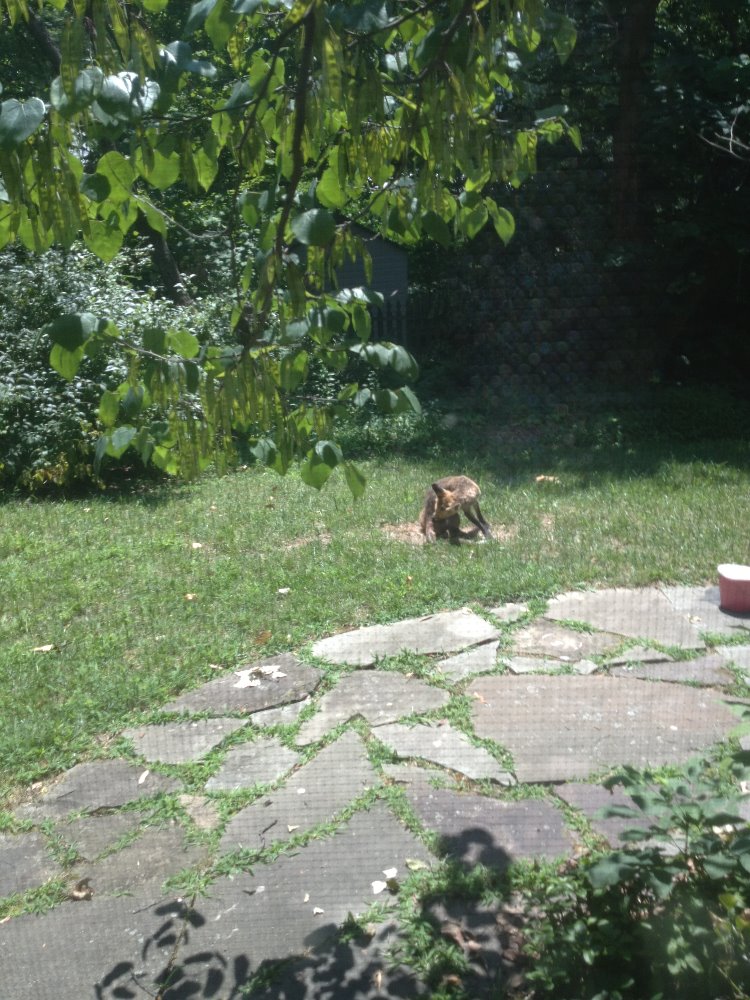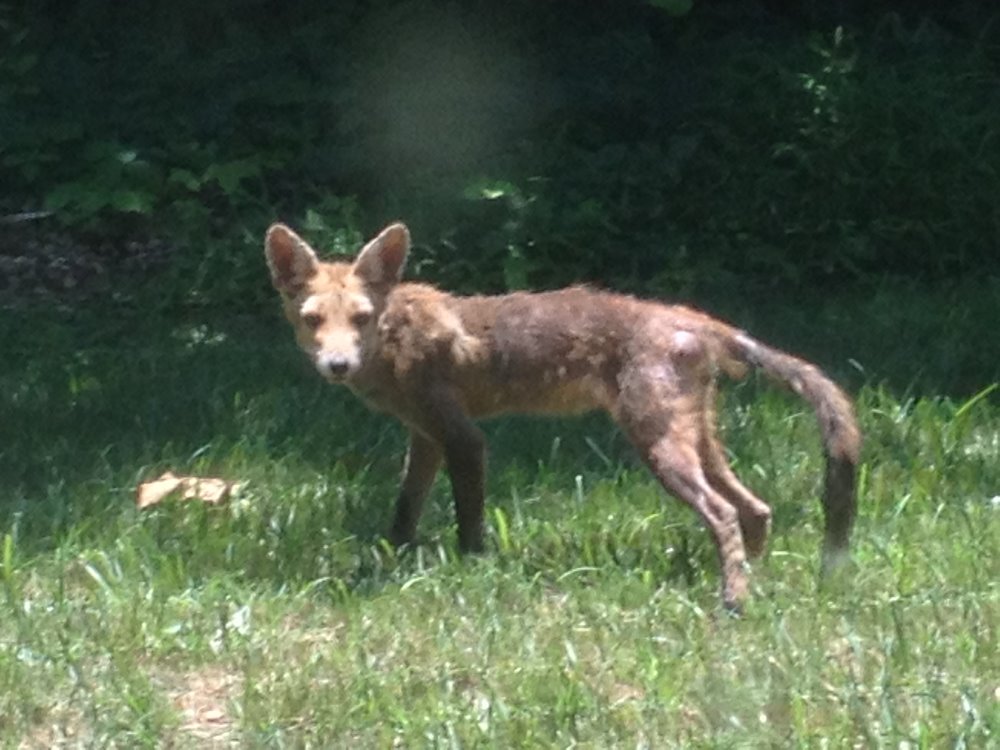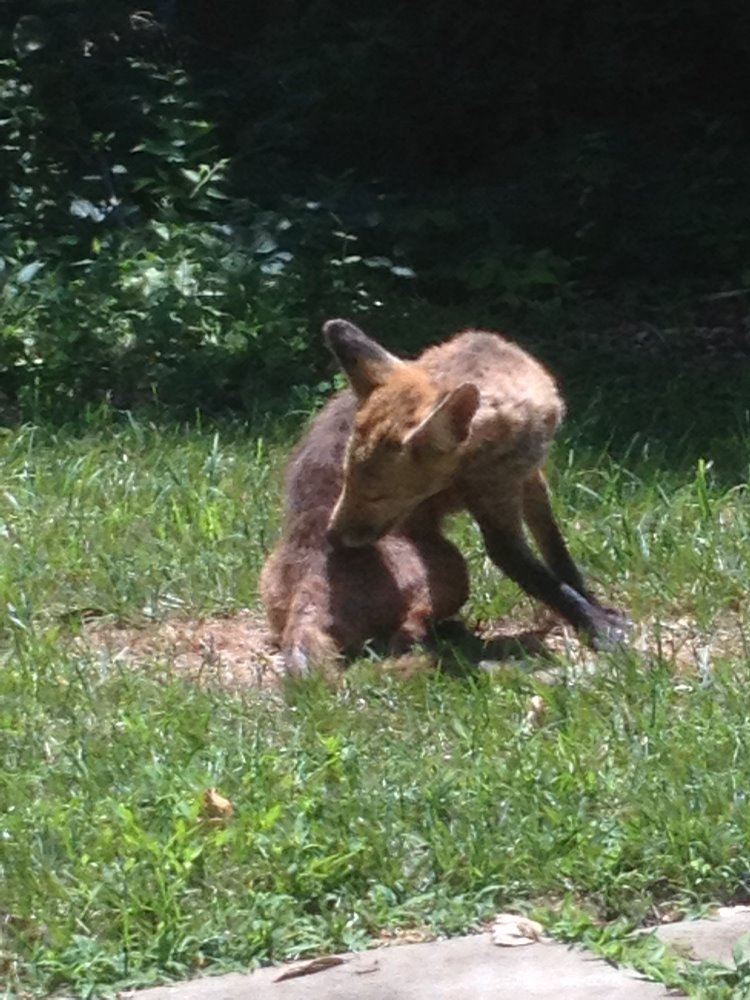Coyotes in Montgomery Square
By Tom Hall
Occasionally, a resident of Montgomery Square will report seeing animals believed to be coyotes. Often these animals are foxes. However, coyotes are known to inhabit our area, and have been spotted since the late 1990s. Local newspapers have reported regular sightings around Falls Grove, and the City of Rockville has posted signs acknowledging Potomac Woods Park as a known coyote habitat. The park backs up to Mongtomery Square and is part of a corridor of woods and parkland, interrupted only briefly by our neighborhoods, linking up to Cabin John Park and others. Reports of red foxes are common as well, and one black bear sighting was reported.
Historically, coyotes were a Western United States species. They were first documented in Maryland in 1972. Coyotes have been moving eastward for most of this century and further population increases in Maryland’s suburban areas are to be expected. There is no state or county program to eliminate coyotes from our area. Their existence here is a permanent feature. Eradication programs in North American suburbs and cities have proven to be ineffective. Trapping and poisoning programs are not practical because they can not discriminate between coyotes, children, pets and other wildlife.
Coyotes resemble medium sized dogs, 35-50 pounds in weight. They have golden brown eyes, bushy tails that are held down when in motion. Colors range from reddish yellow to tan and gray, generally with a lighter “bib” on the neck, darker color on the back than on the underside. They feed primarily on small mammals, including mice, voles, squirrels, and rabbits common in our area. They will eat garbage, birds, eggs, fawns, and — if they can – small pets. Coyotes can be active at any time of day or night.
Conflicts between people and coyotes in our area are still rare. While more and more people are reporting coyote sightings, there have been no reports of coyote bites in Maryland. Coyotes have adequate food supplies in the area without having to attack humans. However, it is important not to encourage coyotes by feeding them or making our yards attractive to them. Things attractive to coyotes should be removed – pet food and water, food waste, trash piles or other rodent habitats.
Aggressive coyotes and any animal bites are serious and must be reported to the Montgomery County Police Department, Animal Services Division, at 240-773-5960 during business hours or 240-773-5900 in an emergency. If a coyote behaves aggressively toward humans, it must be removed from the neighborhood. Simple reports of sightings do not constitute an emergency; and state and county officials will simply offer advice similar that contained here.
If you are concerned about encountering an aggressive coyote, the following measures from the City of Rockville article are recommended. The advice is similar to that used for campers who may encounter bears or other wild animals.
- Keep a deterrent handy. Deterrents can include rocks, pots and pans, tennis balls, tin cans filled with nails or coins to make loud noise and a super-soaker filled with vinegar.
- Appear to be as Big, Mean, and Loud as possible
- Make yourself appear larger, stand, wave your arms
- Throw objects (not food) at the coyote
- Shout in a deep, loud and aggressive voice
- If the coyote continues to approach, DO NOT RUN or turn your back
- Continue to exaggerate the above gestures while maintaining eye contact and moving toward an area of greater human activity.
Children are not immune from harm. Coyotes can surmount a five foot fence and are difficult to keep out of a yard if there is something attractive to them there. Young children are potentially vulnerable, and must be closely supervised if outdoors, even in a “fenced” back yard.
Coyotes, foxes, raccoons, squirrels and other mammals can carry rabies. An animal that acts strangely and attacks humans for no apparent reason may be sick. All wild animal bites should be treated seriously and reported to the County immediately at the Animal Control numbers above.
Pets may be at risk from coyotes, particularly outdoor cats and small dogs. Pets should be indoors or on leashes when outdoors, or closely supervised even when in your backyard. Cats and small dogs should be kept close to you and are vulnerable. Larger dogs are less likely to be attacked, but must be restrained from going after a coyote or other strong, wild animal.
*****************************
Editor's note: On July 4, 2012, Harvey Jacobs, a Montgomery Square resident, took the below photos of a coyote loose in his backyard around 12 noon at 12 Aqueduct Court. MSCA has not received any reports of a coyote sighting since then. Sometimes, residents may confuse a fox sighting with a coyote sighting. We hope the below photos help in differentiating the two. //Bob


Pages
- Home
- News & Announcements
- Community Forum
- About Montgomery Square
- Did you know this?
- Resident FAQ
- Swim Club Memories
- Find us here
- Maps of Montgomery Square
- Wash Post Website Article re M.S.
- Wash Post Article re Mont. Sq.
- History and Stories
- MSCA Presidents (Past & Present)
- Street Name Change History
- Finalized Name Change - July 2021
- Timeline & Other Info
- MC Planning Dept Letter - 6/21/21
- MSCA Flyer - 2/22/21
- MC Planning Dept Letter - 2/5/21
- County Council Letter - 6/6/20
- MC Street Name Change Process Memo
- County Street Naming Manual
- People & Stories
- The Way We Were
- Neighbor Memories - Wonder Years
- Resident Chuck Anziulewicz Memories
- Charity Begins at Home Article
- What is MSCA?
- Pre Mont. Sq. subdivision plats
- Original Marketing Materials
- MSCA Time Capsules
- Directories
- Resident Directory
- MSCA Pet Directory
- Officers and Committee Chairs
- Block Captains
- Teen Services
- Advertise Your Teen Service
- Projects & Initiatives
- Seven Locks Bus Depo & Other Plans
- Paving Project - Fall 2022 - North
- MSCA Free Tree Program
- MSCA Tree-Planting Initiative Info
- How to Mulch a Tree!
- Magazine Article About Mont. Sq.
- Tree Maintenance Tips
- MSCA Free Tree Sign-Up Form
- Oct 2022 Tree-Planting Update
- Oct 2021 Tree-Planting Update
- June 2021 Tree-Planting Update
- March 2021 Tree-Planting Update
- WSSC Water Projects
- WSSC Project Update - South Side
- WSSC Project - South Side 2021
- WSSC Project - North Side 2020
- Ltr from WSSC - North Side 2018
- Ltr from WSSC - South Side 2018
- Ltr from WSSC - Project Update 2013
- Wash Gas Project - South Side 2017
- MSCA Yard Sale Tips and Info
- Seven Locks Bikeway/Safety Project
- Help Our Schools
- MSCA's Other Advocacy Efforts
- Community Documents
- MSCA Newsletters (Tetragon)
- Board Meeting Minutes
- Constitution of the MSCA
- Landscaping Contract for 2024
- Landscaping Contract for 2022-23
- Landscaping Contract for 2021
- Landscaping Cert. of Insurance
- Treasurer's Report (May 20, 2022)
- Treasurer's Report (March 2021)
- Treasurer's Report (Dec 2021)
- Corporate Documents
- Articles of Incorporation
- Insurance Policies
- MSCA Logo
- Misc. Documents
- Living with Foxes
- Sample Street Closure Form & Permit
- Housing Code Enforcement Handbook
- Stepping Stones Shelter Thank You
- Local Information
- New Neighbor Information
- Cabin John Village Plan - 4/25/19
- Cabin John Village Plan - Sept 2017
- Resources for Seniors
- County Alerts
- Walking Your Dog(s)
- Coyotes in Montgomery Square
- Nextdoor Website
- Neighboring HOAs and CAs
- Photo Galleries, Flyers & More
- Street Party Photos
- 11th Annual Block Party (2023)
- 10th Annual MSCA Block Party - 2022
- 10th Annual Block Party - Part 2
- 10th Annual Block Party - Part 3
- 9th Annual MSCA Block Party - 2019
- 8th Annual MSCA Block Party - 2018
- 5th Annual MSCA Block Party - 2015
- 4th Annual MSCA Block Party - 2014
- 3rd Annual MSCA Block Party - 2013
- 2nd Annual MSCA Block Party - 2012
- 1st Annual MSCA Block Party - 2011
- Other Photos/Info
- 2023 Sunday Social
- 2020 Graduation Yard Signs
- Twilight Runfests - 2017 & 2018
- Santa Run & Toy Collection - 2012
- Magic Show & Bike Parade Jul 4 '12
- Joint Labor Day Picnic - 2012
- Ice Cream Social & Yard Sale - 2012
- 3rd Annual Ice Skating Party - 2002
- Holiday Pot Luck Gathering - 2002
- Facebook Page
- Contact Us

